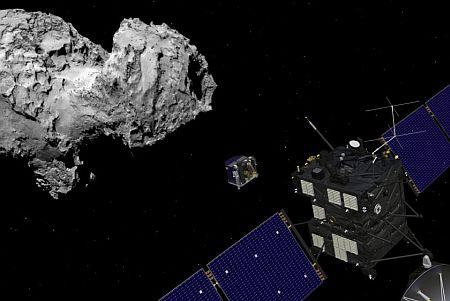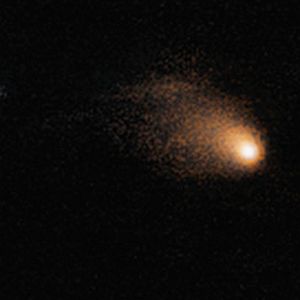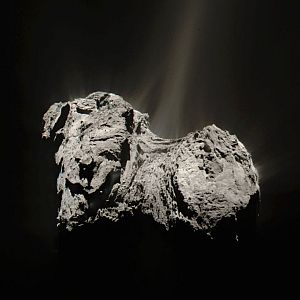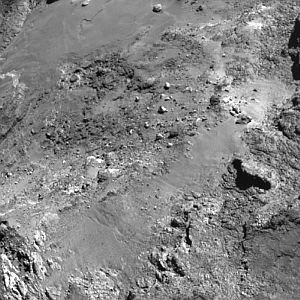
Für eine deutsche Übersetzung dieser Seite einfach die Brandenburger Flagge anklicken
 |
Click the Brandenburg Flag for a German translation Für eine deutsche Übersetzung dieser Seite einfach die Brandenburger Flagge anklicken |


|
|
Churyumov–GerasimenkoA collection of pictures of the first landing
|
|



|
On March 2, 2004, ESA launched the Rosetta probe, which on August 6, 2014 became the
first spacecraft to actually enter into an orbit around a comet. On November 12, 2014, Rosetta's lander Philae touched down on comet 67P/Churyumov–Gerasimenko, performing the first landing on a comet.
Artist's conception of Rosetta and Philae at comet |

| As the Rosetta spacecraft closed in on Churyumov–Gerasimenko, the comet grew from a speck in the sky to a real rock. |

  The comet seen by the VLT Telescope on August 11, 2014; Source: European Southern Observatory |
  One of the first images taken by Rosetta’s OSIRIS camera, July 14, 2014; Source: ESA / Wikipedia |
  Composite image from a distance of 76 miles (123 km), August 5, 2014; Source: ESA / Planetary Society |

| As the comet approached its perihelion (the closest point to the sun), jet activity became more vibrant. |

  Equatorial view, May 3, 2015 Source: ESA / Planetary Society |
  The comet just before perihelion, July 31, 2015 Source: ESA / Planetary Society |
  Silhouette after perihelion, September 10, 2015 Source: ESA / Planetary Society |

| While in orbit, Rosetta took some impressive closup images of the comet's surface. |

  Boulders and blocks from 10 km distance October 28, 2014; Source: ESA / Planetary Society |
  Comet landscape from 8 km distance, October 14, 2014 Source: ESA / Planetary Society |
  Mosaic of Imhotep region from 8.9 km February 14, 2015; Source: ESA / Planetary Society |


|
Leaving asteroids and comets behind, passing the asteroid belt, we enter the outer solar system, home of four giant planets and over 150 moons. The first probe to enter this realm was NASA's Pioneer 10, which passed Jupiter on December 3, 1973. Since then, six other probes have passed Jupiter in gravity assist maneuvers and two probes, Galileo, and Juno have actually entered into orbit around the solar system's largest planet for an extended period of time. |

|


|
|
Click here to return to other comets | Click here to move on to Jupiter |
|

|
Back to Solar System Page |
Back to Space Page |
Back to English Main Page |
 Back to Start Page |